District heating networks can be fed by various heat generation sources, including combustion plants (based on fossil fuel or biomass), CHP (combined heat & power) plants or renewable-based plants. The characteristics of each of these heat technologies are outlined in this article. This review is included in the document “D4. 1 – Energy Price Assesment”, that provides an insight to energy cost in the context of district heating.
The combination of multiple heat sources is beneficial, especially for large district heating schemes, as it allows shifting from source to source depending on specific conditions and market prices. In Figure 1 is shown the heat production mix for European countries.
Figure 1 Heat sources for district heating in EU27.
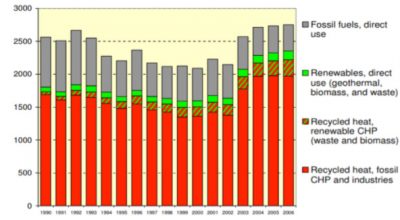
Heat sources for district heating in EU27 (PJ/year). Source: Dr Sven Werner, Halmstad University [1]. © EU Joint Research Centre, 2012.
As a summary, typical features (application, cost, production and performance levels) for each heat generation technology are listed in Table 1. More specific information on these technologies is provided in the relevant subsections.
Table 1. Heating technologies for district heating
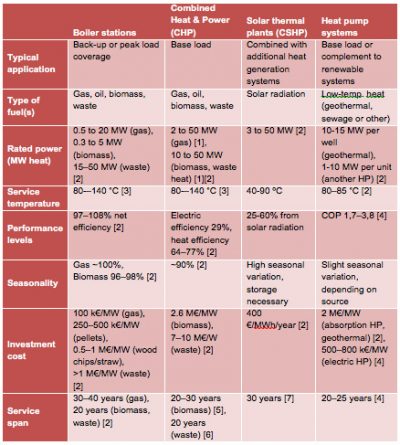
Heating technologies for district heating. References at the end of this paper.
Boiler stations are specifically dedicated to the generation of thermal energy, which is produced through combustion of fossil fuels (such as natural gas, heating oil, coal), renewable-sourced fuels (biomass), or incineration of solid waste. The transmission medium is typically water or steam.
As co-generation plants (described in the next section) are becoming more common (due to the advantage of providing electric power as well, unlike boiler stations), fossil-fuelled heating plants are currently built only as a back-up for peak load coverage or for small utility networks. Their installed power is usually limited (up to 5 MW), while combined heat and power is favoured for larger units.
In the case of fossil-fuelled boiler systems, the main advantage is provided by their centralised layout, which allows a more efficient removal of pollutants, compared with individual decentralised systems. While they also provide a higher efficiency than individual systems, this advantage is offset by distribution heat losses in the network. In special cases, condensing boilers can be used in such heating plants for improving their efficiency. The combination of boiler stations fired by different fossil fuels within a district heating scheme can also avoid the dependence on one energy source.
Biomass-fired heating plants are being promoted within the EU since they provide a more sustainable energy source.
Conversion efficiencies of modern boiler stations are usually above 97% (based on lower heating value), and can exceed 100% if flue gas condensation is used [2]. Older coal-fired power plants used to have a much lower efficiency in the range of 30-40%.
Biomass-fired heating plants are being promoted within the EU since they provide a more sustainable energy source. Thermal energy is usually generated by the combustion of pellets, wood chips or residual wood products. Wood pellets are not economically advantageous for plants above 1–2 MW, as alternative fuels become less expensive for plants above this range. Large volumes for fuel storage can be helpful in securing provision and minimising deliveries.
Waste-to-energy district heating plants are based on the incineration of waste in a furnace. In this way, part of the energy content of the waste is recovered.
Unlike in boiler stations, which are specifically dedicated to the production of thermal energy, in combined heat & power (CHP) systems thermal energy is produced as a by-product of electricity generation. The cogeneration of heat and electricity is more efficient than the boiler systems mentioned above, as the waste heat from electricity production can be recovered. This is achieved through a power station or heat engine that simultaneously generates electricity and heat. The provision of cooling is also possible through this technology, by using absorption chillers to produce cold from by-product heat (100–180 °C).
The efficiency of the total energy conversion (both electricity and heat) ranges from 60% to 80%, which greatly exceeds the efficiency of fossil-fuelled power plants.
The efficiency of the total energy conversion (both electricity and heat) ranges from 60% to 80%, which greatly exceeds the efficiency of fossil-fuelled power plants [8]. In practice, the efficiency or viability of combined heat & power depends on the demand for both heat and electricity, which are rarely coupled in reality. If electricity production is the main goal, as is often the case, storage is necessary and efficiency decreases from theoretical values. Heat-driven operation, where heat production is the main goal, achieves a greater efficiency. If the cogeneration system is able to produce cooling, efficiency is further increased.
CHP plants for district heating are typically sized for providing approximately half the peak load [1], with peaks provided by boiler systems.
Typical fuels for cogeneration are not different to conventional power plants: natural gas, oil, renewable sources (biomass, solar thermal, geothermal) or solid waste. There is also the possibility of integrating solar PV generation. This distribution of fuels for EU-27 is shown Figure 2.
Gas-fired CHP is a well-established technology scalable to different sizes. Direct biomass CHP is currently technically and economically viable for large-scale plants only (above 10–20 MW). Gasification and ORC (Organic Rankine Cycle) technologies can be used to run smaller plants from biomass. Energy from waste is currently used for large-scale schemes, but it is expected that new technology developments will allow its adoption at smaller scale.
Figure 2. Fuel input to Combined Heat and Power plants in EU-27 and EEA countries in 2009. [13]
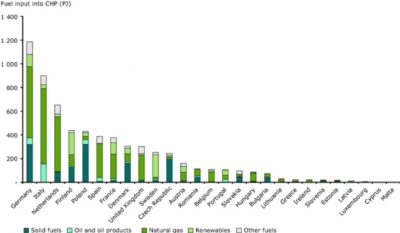
Fuel input to Combined Heat and Power plants in EU-27 and EEA countries in 2009 [13]. © European Environment Agency, 2009.
Solar thermal plants are divided into Central solar heating plants (CSHP) and Building Integrated Solar Thermal Systems (BISTS). CSHP systems are large and centralized systems, usually situated far away from consumption point. On the other hand, BISTS are distributed systems installed near to the consumption point.
Firstly, CSHP provide hot water, heated by arrays of solar thermal collectors. In the case of centralised installations, the collectors are usually installed on the ground (as opposed to individual installations, which are usually installed over rooftops). This is especially true for Nordic countries, where industrial and agricultural land can be found at relatively low price.
Solar plants deliver the highest output in the summer season, when district heating load is low.
Solar plants deliver the highest output in the summer season, when district heating load is low.
Due to the intermittent nature of solar energy supply, large-scale thermal storage (diurnal or seasonal) plays an important role for achieving a high solar fraction in these installations.
Solar thermal plants can also provide district cooling. Energy storage is much less relevant for this application, as usually cooling demand and solar energy supply are highly correlated.
The usual sizes of collector arrays range between 5000 and 50000 m², providing a thermal power from 3 to 50 MW. The largest solar system of the world, installed in 2017 in Silkeborg (Denmark), is an exception in that it doubles the capacity of the high end of the typical range [14].
If suitably protected, solar collectors can work below freezing temperatures and should be protected from overheating on hot sunny days.
The market for large-scale solar water heating is experiencing a fast growth in Northern Europe [1]. In global, the technology has declined by 4,7% in 2017, but positive market developments were recorded in many countries, such as China or India.
The market for large-scale solar water heating is experiencing a fast growth in Northern Europe.
When used for district heating systems, to guarantee energy supply, solar heat plants are with any other heat generation sources for district heating. Solar heat has high investment costs and low operational costs, and so its environmental and economic feasibility needs to be assessed. Generally, solar heating plants are most efficient when combined with gas-fired boiler stations and CHP systems, as these are quick to start and stop and therefore allow a better exploitation of the energy provided by solar plants.
The current production price for solar heating plants is >0.03 €/kWh in Northern Europe and >0.02 €/kWh in Southern Europe [10]. However, the cost is very dependent on the scale of the system, as shown in Table 2.
Table 2. Solar heat cost vs. system size for Denmark.

Solar heat cost vs. system size for Denmark [1]. @ EU Joint Research Centre, 2012.
Heat pumps allow for heat recovery from the ground (geothermal heat pump systems) and alternatively from other low-grade heat sources such as sea water or treated sewage water. It is shown in Figure 3 the potentiality density of this heat source in Europe.
Figure 3. Geothermal heat flow density in Europe, EC 2012. [11]
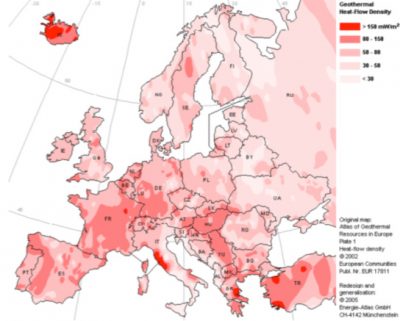
Geothermal heat flow density in Europe, EC 2012 [11]. © EC, 2012 .
The main advantage of heat pumps is that they can make use of energy from low temperature sources.
Absorption heat pumps, powered by thermal energy, usually deliver heat at temperatures of 85–87 °C.
The capacity of large heat pumps is usually in the range of 25 kW to 5 MW. For covering a bigger capacity, a number of heat pumps are usually laid out in parallel.
The main advantage of heat pumps is that they can make use of energy from low temperature sources. Therefore, they provide great flexibility for the use of renewable, waste and surplus energy.
Figure 4. Examples of absorption heat pump (left) and electric heat pump (right) with geothermal heat source (100 units extracted) [2]. © Danish Energy Agency, 2012.
 Examples of absorption heat pump |
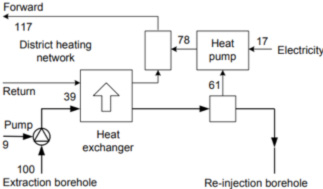 Examples of absorption electric heat pump |
Waste heat from industrial processes, solid waste incinerators or other applications can be recovered using heat exchangers or heat recovery boilers. Most of the energy currently used for district heating in the European Union comes from waste heat from power stations, as shown by Figure 1. Preferably, the heat source should be close to the distribution plant and its temperature should be above 100 °C [12]. In particular, waste heat from nuclear power stations has a high potential as an energy source for district heating, which could be exploited by countries such as France and the UK [1].
Waste heat from nuclear power stations has a high potential as an energy source for district heating, which could be exploited by countries such as France and the UK.
Geothermal district heating, using low-temperature ground-sourced heat, has been used since a long time ago but is only available at specific locations, requiring abundant geothermal heat within a short distance of the heat demand area [2]
Reference
- EU Joint Research Centre. Background Report on EU-27 District Heating and Cooling Potentials, Barriers, Best Practice and Measures of Promotion. 2012.
- Danish Energy Agency. Technology data for energy plans. 2012.
- International Renewable Energy Agency (IRENA). Renewable energy in district heating and cooling. 2017.
- EA Energianalyse A/S et al. Varmepumper og lavtemperaturfjernvarme. 2009.
- Elkraft System. Biomasse kraftvarme udviklingskortlægning – Resume-rapport. 2003.
- Rambøll Danmark. 100 Years of Waste Incineration in Denmark. 2004.
- Department of Civil Engineering, Technical University of Denmark. Life expectancy of solar collectors in solar district heating systems. 2009.
- © IEA-ETSAP and IRENA 2013. Technology Brief E16 – District Heating. 2013.
- Directive 2012/27/EU of the European Parliament and of the Council of 25 October 2012 on energy efficiency. 2012.
- Sørensen, Per Alex. Solar district heating guidelines. 2012.
- EC Publication EUR 17811. Atlas of Geothermal heat resources in Europe. Heat flow density. 2012.
- Werner, Sven. District Heating and Cooling. Encyclopedia of Energy. 2004.
- European Environment Agency. Fuel Input to CHP plants in Eu-27 and EEA countries in 2009, https://www.eea.europa.eu/data-and-maps/figures/fuel-input-to-chp-plants-4 (accessed 2018/04/26)
- Danish Board of District Heating, Record-breaking solar heating system ready on time, http://dbdh.dk/record-breaking-solar-heating-system-ready-on-time/ (accessed 2018/04/26)
